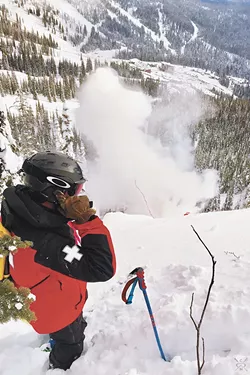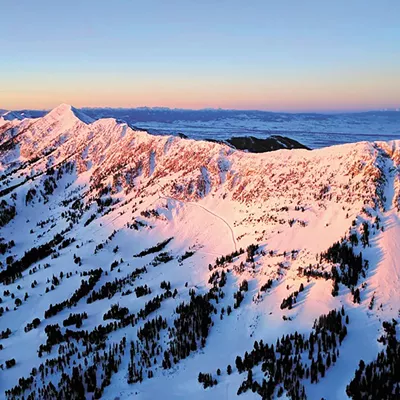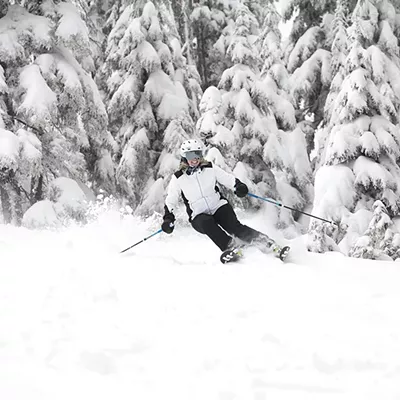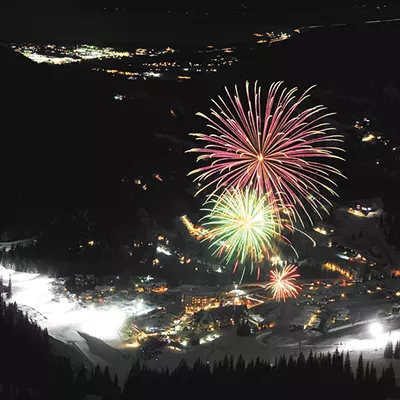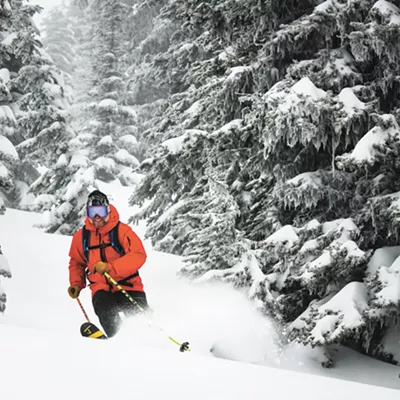It's sometime around 4 am when the alarm chimes start ringing, buzzing, playing music or whatever particular form of disturbance has been chosen by the particular Schweitzer Mountain patroller to roust him or her from a deep winter slumber this powder morning here in North Idaho.
It's 5:45 am when I show up at Schweitzer ski patrol headquarters to join my designated tour guides, so to speak, whom I'm scheduled to shadow as they head out for a morning of avalanche mitigation work. I'm tagging along with Miles, a somewhat recent addition to the SMR patrol who moved to town from Monarch Mountain, Colorado, where he was the assistant ski patrol director, and Kim, a 16-year veteran SMR patroller from Sandpoint. They are the two designated bomb makers this morning and as such the first to arrive on the scene.
It's not long, however, before a number of other patrollers show up and busy themselves with some of the important morning tasks. Tom, the snow safety director, starts gathering weather info from various sources and reviewing the route sheets for each team who will head out to control the hazards on a specific area of terrain. Assistant patrol director Greg is here as well, moving around the room and chatting with fellow patrollers to quietly assure himself that everything is proceeding smoothly and according to plan.
The smooth sounds of Kurt Vile singing "Rollin' with the Flow" emanate from the stereo to create a more mellow backdrop than what my eyes see as more and more patrollers arrive and get busy. Kim calls out over the radio to the overnight grooming staff and receives an update of 8-10 inches up top and remarks that with the wind effect this could easily be 16 inches in some spots.
It's 6:20 am when snow safety director Tom calls out the relevant info and plan of attack for the day. Then Kim, Miles and I head out into the morning darkness to saddle up on snowmobiles and head to the bomb cache tucked away on a ridge high atop the mountain. Zooming into the darkness, the heavy snow falling is illuminated in the machine headlights, creating a look that can't help but make one think of the Millennium Falcon launching into hyperspace. A few minutes later we arrive at the bomb cache, a sort of mini-Fort Knox housing gold of a completely different variety. Headlights shining directly on the thick metal box to light up the darkness, Miles and Kim release the double-locked door and carefully document each explosive, then load the explosives onto snowmobiles and head off to two designated locations where they will begin assembling the bombs.
The actual assembling is typically pretty solitary work as the bomb maker will usually be the only person in the mountaintop shed as they insert caps and fuses into the explosives and put them into their final stage — now needing just to be ignited. However, on this morning I'm here, too, observing as Kim assembles the 20 or so bombs which will be carried by the teams working in her zone this morning. Soon the smiling faces of fellow patrollers begin to fill the room and I can feel a palpable sense of camaraderie amongst this group of individuals charged to work together on such a serious task.
With the explosives divided amongst the teams, I head out onto the ridge above Schweitzer's North Bowl with route leader/thrower Kim and her teammate/packer Leigh. As we move from one carefully selected location to another, a certain routine is revealed. Kim decides on where best to place the explosive based on terrain and wind loading and is then provided an explosive by Leigh. The final decision on where to place a particular charge becomes almost an art to a veteran patroller with as much experience as Kim.
After attaching a long ribbon that can be used to retrieve the explosive in rare "no light" situations, Kim will ignite the fuse using a device known as a spitter and then lob it into the location she has determined will provide the best results. At that same time, her packer, Leigh, begins a two-minute countdown and places a "fire in the hole" radio call noting their location. At the 1:30 mark of the countdown, Leigh will announce the remaining time and we cover our ears and open our mouths to lessen the effect of the nearby concussion. Following the explosion of the charge, Kim and Leigh observe and discuss the movement of the snow it caused before carefully moving on to the next location and starting the process over again. Simultaneously, this same process is unfolding with the four other teams spread out across the 2,900-acre ski area. These teams will continue to work diligently throughout the early morning hours, throwing charges, ski-cutting ridgetop wind deposits and communicating their shared results until they can collectively be sure that each and every zone is safe for the public to ski.
Following my morning of observation, I head out to free ski the resort and the patrollers head off to continue on with a workday, which, in all reality, has just begun. As I ski my first few laps, my mind begins to reflect on the seriousness of the work I've just witnessed — teams of highly skilled and licensed professionals with decades of combined experience dispatched to a variety of locations across the vast mountain landscape working ever so diligently to keep skiers just like myself safe from harm.
I've stood in line at a chairlift on more powder mornings than I could ever count and on more than a few of those mornings listened to the complaints of fellow snow sliders when certain lifts or terrain don't open as early as those anxious riders would like. Considering the amount of work I witnessed over the course of the morning, and the seriousness of its nature, I'd suggest that all those bit chompers sit back, relax and be thankful that ski patrollers are willing to get up so early and work so hard just to keep those very people alive to ski another day. After all, the key to skiing as much fresh powder as possible isn't just getting out there early, but also staying alive to ski another day. ♦


